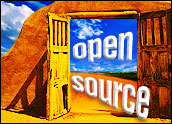
PHP (hypertext preprocessor) developer Zend Technologies announced Monday the release of version 1.0 of Zend Framework, an open source application framework for PHP.
Zend Framework 1.0, pre-released in beta versions since last year, is the result of collaboration from230 contributors comprised of individual developers and company-sponsored committers, including fromGoogle and IBM.
“We were pleasantly surprised with the 1.4 million downloads between the first two days. Those are pretty impressive numbers showing a fantastic uptick in interest,” Kent Mitchell, director of product marketing, told LinuxInsider.
“Zend Framework’s goal is to provide a high-quality open source framework for developing Web applications and Web services,” said Andi Gutmans, co-CTO and cofounder at Zend Technologies.
What It Does
Zend Framework is designed to help software companies speed up their Web application development. It provides developers with a Windows-based platform.
“The philosophy that existing with the pre-release versions is the same as we follow now. But there is alot more functionality in the version 1.0,” Mitchell said.
Examples of Zend Framework’s effectiveness are IBM, online advertising firm Right Media and Web servicescompany StrikeIron, according to Zend officials. StrikeIron used Zend Framework to create a StrikeIron API to provide real-time access to a diverse set of data sources and functionality over the Web.
IBM used Zend as one of its core frameworks for Ajax and Web Services supporting its QEDWiki, which allows line of business professionals to assemble mashups from disparate sources on demand.
Right Media used Zend’s PHP framework to cut its development time to six months for its Right MediaExchange, an application used by advertisers and publishers to buy and sell online ad placements in realtime through auctions.
Commercial Adoption
A key feature of Zend Framework is its ease in being adopted for commercial purposes, noted Gutmans. For instance, all contributors to the framework have submitted their code under an Apache-style contributor license agreement (CLA), so that companies can deploy Zend Framework based applications without concern for IP violations.
Also, Zend Framework is released under a BSD (Berkeley Software Distribution) license. This enables users to include the framework code in their own Web applications without any constraints on use.
The lack of use restrictions for the architecture means that users can gradually adopt Zend Framework and use as much or as little of its functions as their applications require, avoiding the lock-infrom the “all-or-nothing” architecture of other frameworks, according to Mitchell.
How It Works
Zend Framework is based on simple object-oriented best practices and a lightweight architecture. Thisenables faster development of interactive Web applications. It is comprised of numerous components.
MVC application framework is Zend Framework’s model view controller architecture. It enables theseparation of business logic from user interface design. The framework also makes AJAX (Asynchronous JavaScript and XML) programming easier with JSON (Javascript Object Notation) support.
Database support provides access to multiple brands of RDBMS (relational database management systems) via a database-independent object-oriented interface. Databases supported include IBM DB2, MySQL, Oracle, Microsoft SQL Server, PostgreSQL and SQLite.
Big on Web Services
“We’ve invested heavily in Web services. Everything works out of the box,” Gutmans told LinuxInsider.
Web services provides convenient classes to publish and consume Web services and feeds in PHP. These feedsinclude Atom, RSS (really simple syndication) and Google data APIs (application programming interfaces).
Zend Framework uses REST, HTTP and XML-RPC clients and servers. It integrates a multitude of industry Web services, including APIs from major providers like Amazon, Yahoo and StrikeIron.
Foundation Framework services provide many other classes to make common application development tasks quick and easy. For example, solutions for e-mail, sessions, authentication, logging, caching, filtering input and others are included.
Zend Framework 1.0 can be downloaded here.
“We expect the momentum to increase with this official release,” Mitchell said. “Many people don’t like to try beta versions.”




















































